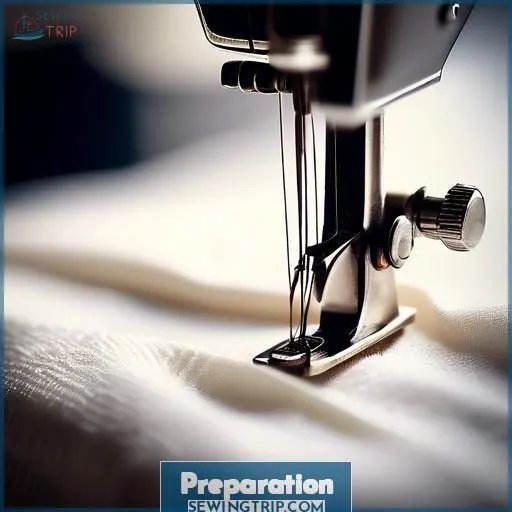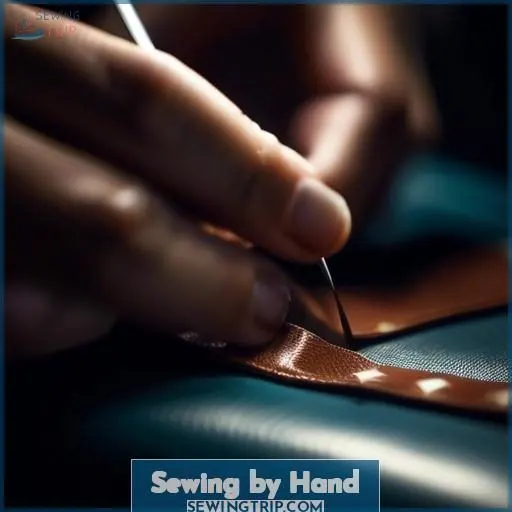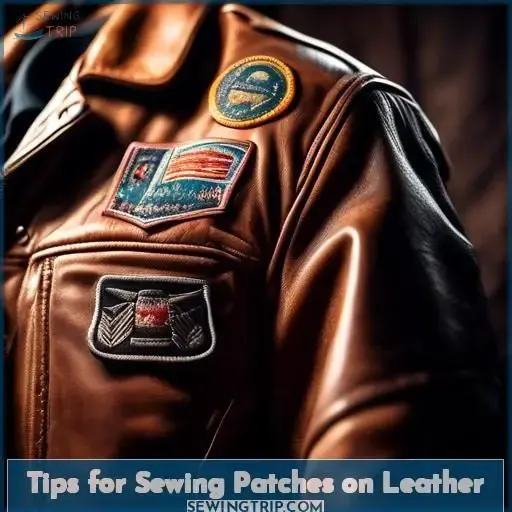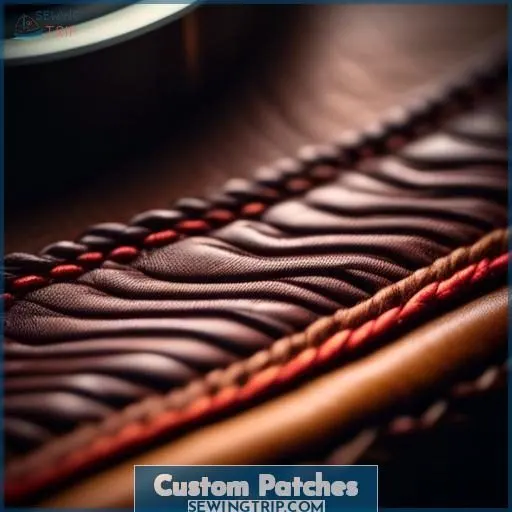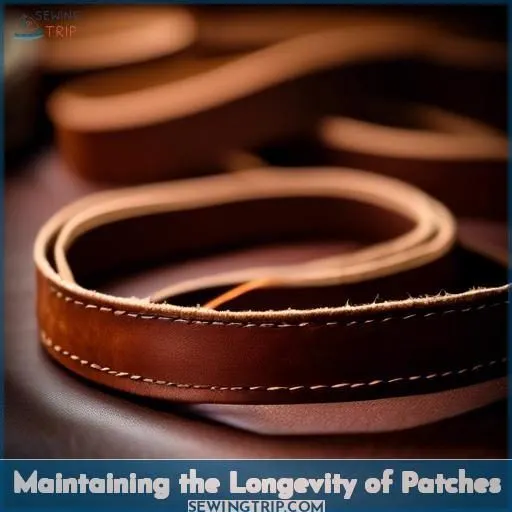This site is supported by our readers. We may earn a commission, at no cost to you, if you purchase through links.

To expertly sew patches on leather, start by preparing the surface. Clean the leather, and mark the desired patch placement. Test your stitching on a scrap piece.
When sewing by hand, use a sharp needle and 100% polyester thread. Secure the patch with adhesive first.
For machine sewing, select a setting for leather and wind the bobbin with polyester thread. Always use sharp needles and stitch close to the patch’s edge. Knot the thread securely when finished.
Remember to secure the patch before sewing for best results. To dive deeper into sewing patches on leather, read on for more detailed tips and tricks.
Table Of Contents
Key Takeaways
- Start by preparing the leather surface by cleaning it and marking the desired patch placement.
- Use a sharp needle and 100% polyester thread for hand sewing, and secure the patch with adhesive before sewing.
- Select a leather setting on the sewing machine and wind the bobbin with polyester thread for machine sewing.
- Sew close to the patch’s edge, knot the thread securely, and remember to secure the patch before sewing for best results.
How to Sew Patches on Leather?
To sew patches on leather, follow these steps:
- Thread a needle with the appropriate thread color and knot one end to prevent it from slipping through the fabric.
- Position the patch on the desired location, ensuring it’s aligned as intended. Use pins to keep it in place while you work.
- Choose a basic or decorative embroidery stitch, depending on your preference.
- Pass the needle through the patch and the leather jacket fabric, securing the patch tightly.
- Continue stitching around the patch until it’s completely attached.
- Knot the thread on the inside of the jacket to secure it.
Remember to use a heavy-duty needle and thimble to protect your fingernail. If you can’t remove the lining, try to keep it smooth and centered so as not to tear or bind when you put it on. Keep each stitch close so it won’t come loose or get caught and ripped.
Preparation
Preparation is essential for successful sewing of patches on leather. To achieve a desirable result, adhere to these steps:
- Select suitable materials and equipment, including a leather needle, 100% polyester thread, and a sewing machine with a leather setting if applicable.
- Examine the patch for cleanliness and perfection. This will help determine its suitability for attachment to the leather item.
- Prepare the leather item by marking the desired patch placement with a fabric marker or tailor’s chalk.
- For machine sewing, test the stitching on a scrap piece of leather to assess the stitch length and tension. Make necessary adjustments to the machine’s settings.
- Before sewing the patch onto the leather item, secure it in place using tape, adhesive, or pins. This will prevent the patch from moving during the sewing process.
- Choose the appropriate stitching technique, such as saddle stitching or a decorative embroidery stitch, based on your preference and the patch design.
- Sew the patch onto the leather item, beginning from one edge and continuing around. Overlap the first and last stitches by 1 to 1 1/2 inches to create a secure finish without the need for backstitching.
- Once the patch is sewn on, trim any excess thread and remove visible marker or chalk lines. Inspect the patch to identify and correct any loose threads or imperfections.
Sewing by Hand
Hand stitching techniques are an art form in their own right. When it comes to leather patches, the right embroidery thread selection and patch placement strategies are essential. Leather preparation is also important, ensuring that the leather is clean and free from debris. With a needle rated for leather work and 100% polyester thread, you can begin your hand sewing journey.
Adhesive alternatives like tape or spray adhesive can be used to hold the patch in place before you start sewing. Remember to knot the thread securely after sewing to maintain the durability of your patches.
Sewing With a Sewing Machine
When sewing patches onto leather with a machine, be sure to select one with a designated leather setting. Wind the bobbin with 100% polyester thread, which will provide a strong, durable stitch on the tough leather material.
Select a Machine With a Leather Setting
To sew patches on leather jackets, vests, and more, you’ll need a sewing machine with a leather setting. This setting makes sure the machine can manage the thickness and texture of leather.
Before you start, wind a bobbin with 100% polyester thread, which is the best choice for sewing on leather. Remember, needle sharpness and thread selection are critical for patch security.
With a leather machine, sewing patches on leather becomes easy, giving your leather jacket a professional appearance.
Wind a Bobbin With 100% Polyester Thread
To wind a bobbin with 100% polyester thread, first select the appropriate machine setting for leather.
Thread the machine with 100% polyester thread. This thread choice is essential for patches on leather, as it provides the best adhesion and durability.
Tips for Sewing Patches on Leather
Sewing patches on leather necessitates a skillful hand and specialized techniques. Employ sharp needles, opt for 100% polyester thread, and be certain to secure the patch with tape or adhesive prior to stitching near the edge – then fasten the thread tightly to guarantee the patch remains in place.
Use Sharp Needles for Leather
To attach patches to leather, you’ll require a piercing needle. A piercing needle is essential for penetrating the leather without inflicting damage. Needle sharpness impacts needle endurance and machine suitability.
For thicker leather, opt for a needle with a more extensive eye. For patch application, a triple stitch is frequently employed for enhanced resilience.
Bear in mind that leather jackets necessitate routine cleaning and upkeep, so verify your needle is capable of handling the task.
Choose 100% Polyester Thread
Regarding leather patch sewing, selecting the ideal thread is pivotal for the stitch’s endurance and strength. Key considerations include:
- Thread Caliber: The thread’s thickness should correspond with the leather’s thickness. For substantial leather, a thicker thread is advised, while a finer thread may be suitable for thinner leather.
- Thread Hues: The thread’s color should complement the leather or patch to achieve a cohesive appearance.
- Polyester Thread Attributes: Polyester thread is a favored option for leather sewing due to its resilience and durability. It can withstand the challenges of sewing through thick leather layers and endure tension.
When choosing thread for leather patch sewing, bear in mind:
- Thread Providers: Seek reputable thread suppliers specializing in leatherworking thread.
- Thread Accessibility: Confirm that the thread is readily available and compatible with your sewing machine.
- Topstitching Thread: For precision stitching using a topstitching foot, select a thread designed for topstitching.
- Sweatshirt Material: When sewing patches on leather jackets, consider using thread appropriate for sewing sweatshirt fabric.
- Tiny Remnants: Keep small thread remnants on hand for minor projects or repairs.
Secure the Patch With Tape or Adhesive Before Sewing
To secure the patch with tape or adhesive before sewing, consider the following tips:
- Tape Selection: Choose a tape or adhesive that’s compatible with leather and has a strong adhesive strength. Some options include shoe-goo, permanent fabric glue, or self-adhesive leather repair tape.
- Adhesive Strength: Make sure the adhesive is strong enough to hold the patch in place during the sewing process. Be cautious when using glue, as it may discolor the leather or leave visible residue on the fabric or patch.
- Patch Placement: Align the patch on the leather jacket, ensuring it’s in the desired location and properly positioned. Use pins or clips to hold the patch in place while you work.
- Needle Penetration: When sewing through the patch and leather, use a sharp needle rated for leather work to minimize damage to the materials.
- Fabric Compatibility: Select an adhesive that’s suitable for both the leather jacket and the patch material. Some glues may not adhere well to certain fabrics or patch backings, so it’s essential to choose the right adhesive for the job.
Stitch Close to the Edge of the Patch
To make sure a patch on your leather jacket looks professional, stitch it close to the edge. This careful stitching requires the right choice of needle and thread. Change the length of the stitches to match the material of the patch, and think about where you want to put it.
By stitching close to the edge, you’ll make sure it’s attached securely, which will make your jacket look even better overall.
Knot the Thread Securely After Sewing
Sewing patches on leather necessitates a robust and dependable knot to guarantee the patch’s permanence. The knot’s strength is vital for the stitching’s durability. Here are some guidelines for securely knotting the thread post-sewing:
-
Thread Tension: Confirm that the thread tension is suitable for the leather material. Excessively tight or loose stitches can compromise the patch’s attachment.
-
Needle Sharpening: Employ a sharp needle for sewing leather, as a dull needle can cause the thread to fray or break.
-
Stitch Length: Adjust the stitch length to complement the thickness of the leather and patch material. Longer stitches may be necessary for thicker materials to secure the attachment.
-
Overcasting: If using an overcast stitch, make sure to secure the thread on the backside of the patch to conceal the stitches on the front.
To create a secure knot, follow these steps:
-
Thread the Needle: Thread your needle with 100% polyester thread, which is well-suited for sewing on leather.
-
Knot the Thread: Tie a knot at the end of the thread to secure it.
-
Pull the Thread Through: Push the needle up through the leather’s back and out through the patch’s front, as close to the edge as possible.
-
Stitch Around the Patch: Make stitches of equal size around the patch’s edge, pulling the thread through until the knot halts it.
-
Remove the Tape: Before you stitch the entire perimeter, remove the tape (if you used tape).
-
Finish the Knot: Continue stitching until you reach the first stitch, then push the needle through to the garment’s inside. To make a knot, slide the needle under a stitch and pull it through until a small loop of thread remains. Pull the needle through the loop to form a knot. Repeat the knotting process twice to create a strong knot.
-
Trim the Thread: Trim the thread, leaving a short tail.
Custom Patches
Crafting the perfect custom patch for your leather goods is a breeze. You can choose from a variety of materials, sizes, and shapes, and get a free quote and sample patch shipped to you quickly at no extra cost.
Create Custom Patches From Original Designs
To create custom patches from original designs, start by selecting unique designs that resonate with your personal style or brand. Consider the materials you want to utilize, as they can influence the durability and appearance of your patch.
Size variations and shape options are also important, as they can impact the overall look and feel of your patch. Once you have your design and materials in mind, request a quote and sample patch to ascertain you’re satisfied with the final product.
Choose From Various Materials, Sizes, and Shapes
When creating custom patches, you have a vast array of choices to make. You can opt for the materials, sizes, and shapes that align most suitably with your requirements. The quality of the material is of paramount importance, as it influences the durability and aesthetic appeal of your patches. Polyester, nylon, and leather are frequently used materials.
In terms of shape, you can select from circular, triangular, rectangular, square, or shapes that are tailored to your specific needs. The size of your patch will vary depending on the design and the intended placement. You can employ the formula Size = (Height+Width)/2 to ascertain the appropriate size to order. Bear in mind that the patch should be of sufficient size to attract attention.
Get a Free Quote and Sample Patch
Embarking on the realm of bespoke patches? Commence by obtaining a free estimate and specimen patch**. It’s akin to a furtive glimpse into the destiny of your leather masterpiece. This measure verifies that the specimen’s caliber fulfills your discerning expectations, while also enabling you to experiment with material choice and design potential.
It’s your initial foray into the boundless realm of personalization.
Fast Production Turnaround Times
Rapid production turnaround times are essential for effective delivery of custom patches. Here’s how to attain it:
- Select a dependable patch maker with a demonstrated history.
- Submit precise specifications and thorough designs.
- Choose digital printing for accelerated production.
- Stay in regular communication with the manufacturer.
- Be willing to pay an additional charge for expedited services.
Free U.S. Shipping
Experience the convenience of free U.S. shipping when you order custom patches. Enjoy fast shipping times without the added cost, making your patching project even more affordable. With our commitment to speedy delivery, you can expect your patches to arrive promptly, allowing you to sew them onto your leather jackets or vests without any delay.
Maintaining the Longevity of Patches
After crafting your custom patches with finesse, ensuring their longevity is like safeguarding a precious artifact. Here’s how to preserve these badges of honor in pristine condition:
- Select patch materials that endure the ravages of time and the elements.
- Employ adhesive solutions that adhere steadfastly without compromising the leather’s integrity.
- Invest in robust thread; it forms the foundation of your patch’s resilience.
- Maintain the needle’s sharpness to prevent missteps and irregular stitches.
- Master stitching methods that combine strength with elegance for a finish that endures.
Frequently Asked Questions (FAQs)
What type of needle is best for sewing patches on leather?
Let’s take a cue from master leathersmiths – you’ll want a leather needle for this job. Sharp as a tack, they’ll pierce through that tough hide like butter, ensuring your patches stick around for the long haul.
Can I use spray adhesive to attach the patch before sewing?
You can absolutely use spray adhesive to temporarily hold patches in place before sewing on leather. Just give it a light, even misting on the back—enough to make it tacky without soaking through.
What is the best way to secure the patch in place while sewing by hand?
The best hack? Grab some carpet tape—it’ll hold that sucker in place like nobody’s business. Just lay it down, slap the patch on top, and you’re good to go. No slippin’ and slidin’ while you’re stitchin’!
How do I adjust the stitch length on a sewing machine for leather?
Your sewing machine’s stitch length control is the key to conquering leather. Turn that dial up high, like scaling a mountain peak, and those sturdy stitches will grip that leather patch like a vise. Just keep your tension balanced for smooth sailing.
What should I do if the leather needle bends or breaks during sewing?
If your leather needle bends or breaks, you’ll need to replace it immediately. A damaged needle can ruin your leather and patches. No exceptions – dull or bent needles lead to costly mistakes. So stay sharp, my friend!
Conclusion
Assuredly sew patches on leather jackets, vests, and more by appropriately preparing the surface, securing with adhesive, and using sharp needles with polyester thread. Carefully stitch close to edges, knotting securely when finished. Creating custom patches enhances uniqueness – explore novel designs, materials, and sizes. Proper care extends patch durability, ensuring your expertly sewn embellishments endure.

